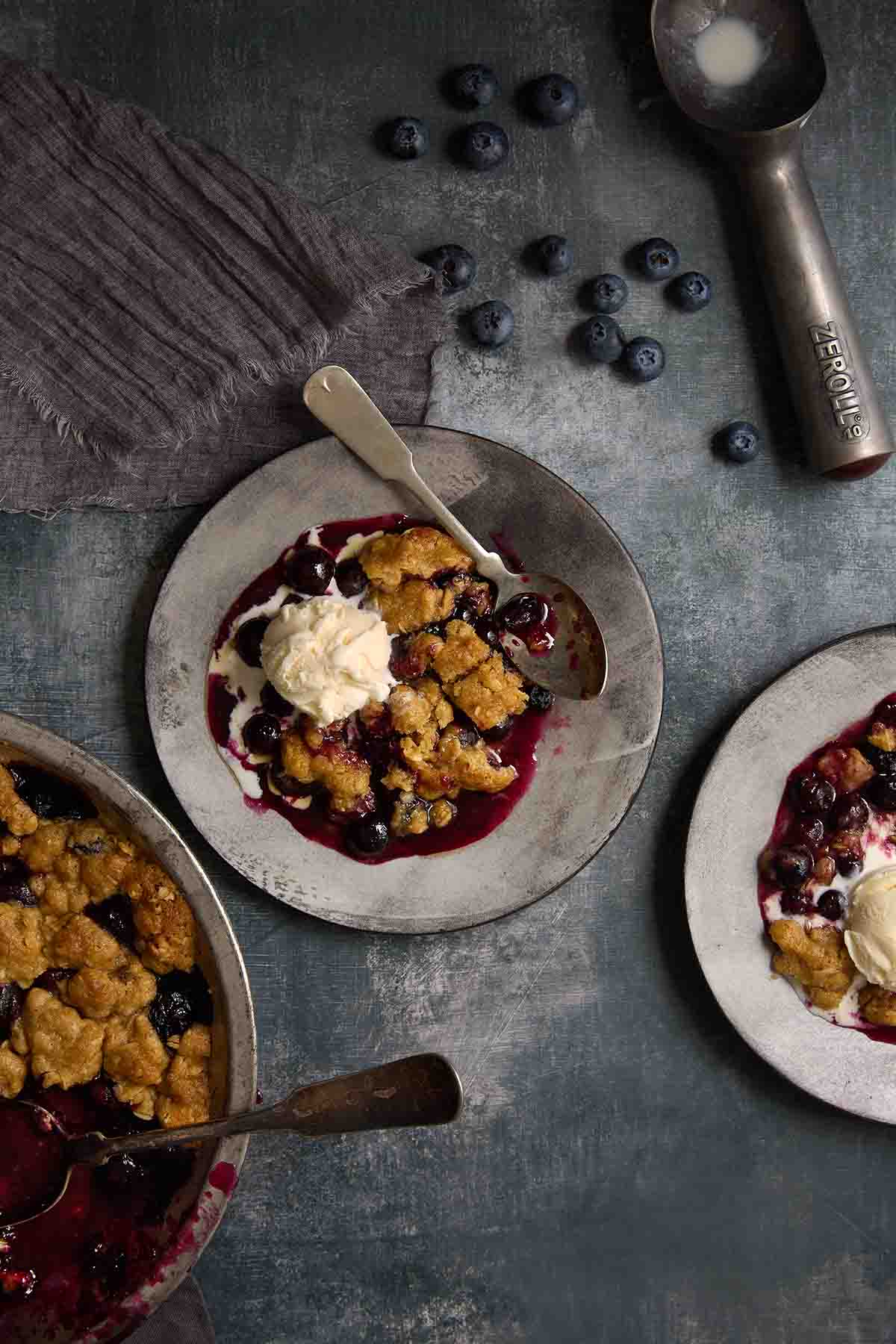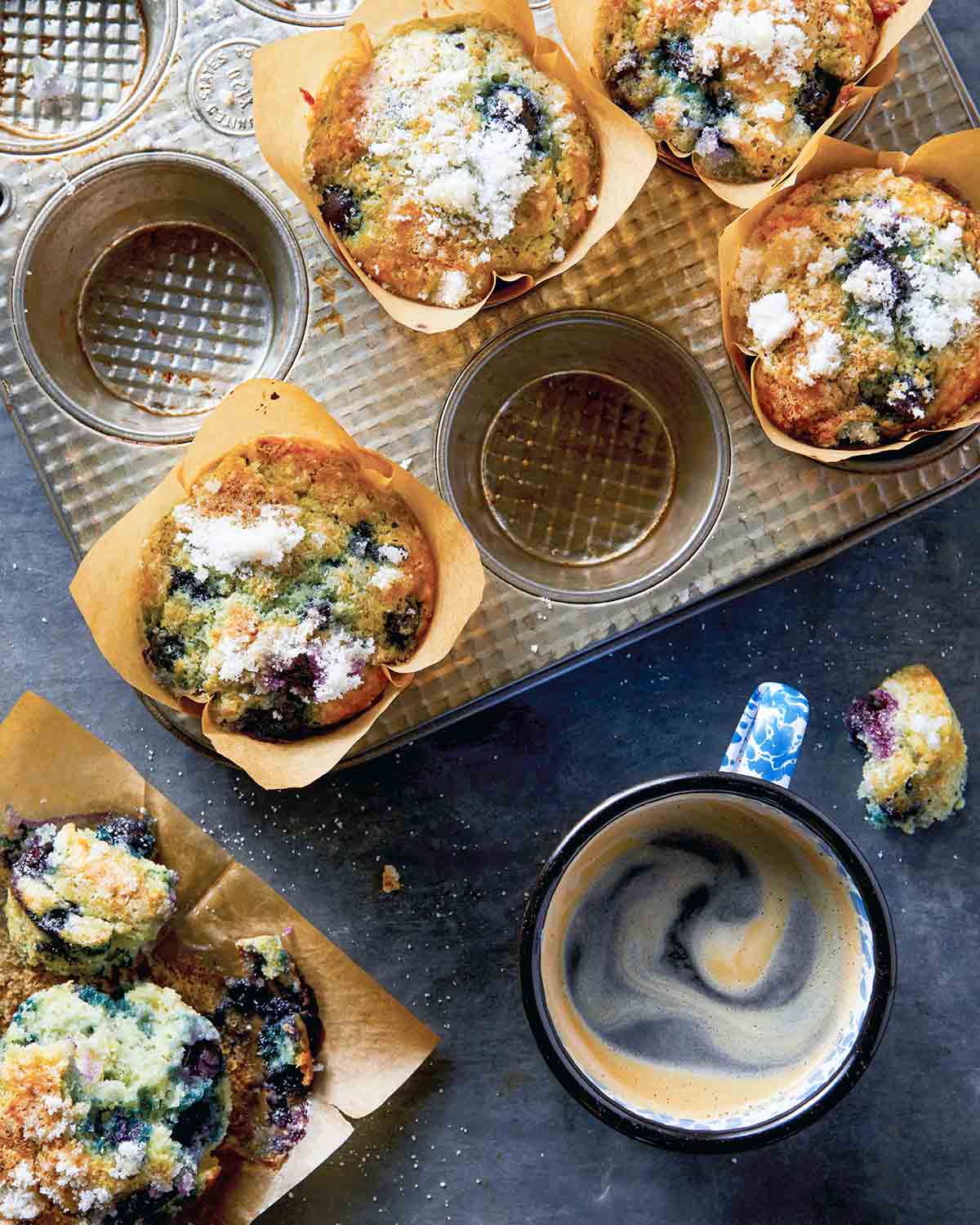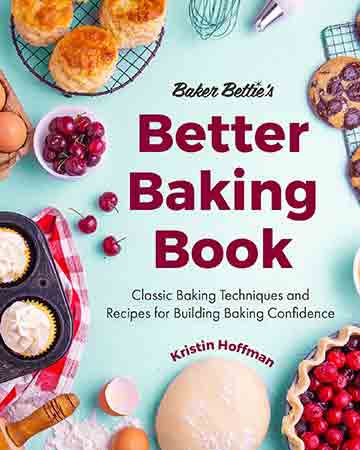
These blueberry lemon scones are American bakery-style scones that are slightly fluffier, sweeter, and closer to a pastry than many scones found outside the US. These are also often topped with a confectioners’ sugar glaze. Additionally, try making cranberry scones or make these plain and serve with whatever fillings you like or used as the base of strawberry shortcake.–Kristin Hoffman
Blueberry Lemon Scones FAQs
Once they’re baked and ready to be served, simply break your scones apart using your fingers and eat as you would any other pastry. As the author suggests, you may use your scones as a base for strawberry shortcake (honestly, we can’t get that one out of our heads and need to make scones right now), or you may choose to slice them open and add butter, Meyer lemon curd, or blueberry jam.
While heavy cream is called for in this recipe, if you’re in a bind, you can substitute milk and butter for cream and get virtually the same final results. Simply use 1/4 cup of melted butter and 3/4 cup of milk for each cup of heavy cream required.
You may be more familiar with an egg wash (which you can use here instead if you prefer). The egg wash that we typically use on pies and pastries creates a lovely glistening shine on baked goods, but the protein and sugars in the heavy cream will add a touch of color to otherwise pale scones. The fat in the cream will also lend a bit of shine to the tops.
Using very cold (or even frozen) butter allows the dough to stay cold right up until it goes into the oven. At that point, the butter melts, creating light, tender scones that don’t spread.
More Summery Blueberry Recipes



Blueberry Lemon Scones
Ingredients
For the scones
- 2 cups all-purpose flour, plus more for working the dough
- 1/2 cup granulated sugar
- 1 tablespoon baking powder
- 1/2 teaspoon kosher salt
- 1 stick (4 oz) unsalted butter, very cold, cut into small cubes or grated
- 1 cup fresh or frozen blueberries, (if using frozen, keep frozen, do not thaw)
- 1 large egg, cold
- 1/2 cup heavy cream, cold, plus a few tablespoons of additional heavy cream for brushing the tops
- 1 tablespoon lemon zest, preferably organic
- 1 tablespoon fresh lemon juice
- Coarse sugar, for topping (optional)
For the lemon glaze
- 1 cup confectioners’ sugar
- 1 tablespoon lemon zest, preferably organic
- Pinch salt
- 2 to 3 tablespoons fresh lemon juice
Instructions
Make the scones
- Position an oven rack in the center position. Preheat the oven to 425°F (220°C). Make sure you give the oven ample time to preheat, as the scones will spread too much if it isn’t hot enough.
- Line a rimmed baking sheet with parchment paper or a silicone baking mat.
- In a large bowl whisk together the flour, sugar, baking powder, and salt.
- Add the pieces of cold butter to the mixing bowl and cut it into the flour mixture. To do this, press down on the fat with the wires of a pastry blender or the tines of a fork as you move it around the bowl. Continue cutting the fat into the flour until most of the pieces of fat are about the size of peas, with some pieces being about the size of a walnut half.
- Toss the blueberries throughout the flour and butter mixture.
- In a separate bowl, lightly whisk together the egg, heavy cream, lemon zest, and lemon juice.
- Pour the wet ingredients into the dry ingredients and mix with a silicone spatula just until the liquid is absorbed. This should only take a few turns. The dough will look incohesive, but it will come together on the counter in the next step.
- Turn the dough out onto a lightly floured countertop and flour the top of the dough. The dough is typically very crumbly at this point; this is normal. Use a bit of pressure to press the dough together into one mass.
☞ TESTER TIP: Working the dough on top of a sheet of wax paper makes it easier to fold the dough, using the paper to help lift it.
- Press the dough out to about a 1-inch (2.5-cm) thick rectangle.
- Using a bench knife (or a metal spatula), fold the dough in half and then turn it 90 degrees. Pat out and fold again for a total of 6 times. The dough will likely crumble during the first few turns. Be very gentle and keep patting it back together. This process is creating layers which will create flaky scones. If you use frozen berries, it can make this dough moister and trickier to work with. Dust more flour on top of the dough as needed to make it manageable.
- Pat the dough out to about a 7-inch (18-cm) circle (about 1.5 inches or 4 cm thick). Cut into 8 triangle-shaped pieces. I like to use a bench knife for this, but a sharp knife also works. Transfer the scones to the prepared baking sheet. Brush lightly with cream and sprinkle liberally with coarse sugar, if desired.
- As an optional step, place the sheet pan in the freezer for 10 minutes before baking. This will ensure that your scones will not spread too much and will allow your oven to fully preheat.
- Bake until golden brown and firm when gently pressed, 14 to 18 minutes.
- Transfer to a cooling rack and allow to cool for at least 10 minutes before adding the glaze.
Make the lemon glaze
- While the scones are cooling, in a small bowl, combine the sugar, zest, and salt. Add the lemon juice bit by bit, whisking until you have a thick glaze, about the consistency of honey. It should flow slowly off the whisk in a steady stream. If the glaze gets too thin, you can add a bit more sugar to thicken it back up. Drizzle cooled scones with glaze.
- Store leftovers, completely cooled, at room temperature, wrapped in foil or plastic wrap, for up to 2 days. Alternatively, you can freeze the scones raw and bake them straight from frozen at 425°F (220°C) for 18 to 22 minutes, until baked through.

Explore More with AI
Nutrition
Nutrition information is automatically calculated, so should only be used as an approximation.
Recipe Testers’ Reviews
Oh Mylanta, these glazed blueberry lemon scones were delicious! I was a little skeptical at first, as I’ve never laminated scones before, but it was completely worth the effort. I made them with gluten-free flour, and while some recipes do not convert well to becoming gluten-free, this was not the case. These were extremely flaky and light. The flavors were beautifully balanced as well, although I may add a few more blueberries next time but that is it! Furthermore, I love how these are made with mostly pantry staples. I will be making these again for sure.

This is the first ’10’ I have given a recipe and will be my new go-to blueberry scones recipe. The scones are bursting with bright lemon and blueberry flavor and were easy enough for me to make before school for my kids. The recipe made 8 large scones that could easily be cut in half to give you 16 small scones. While sweeter than other recipes, the lemon flavor adds some tang to keep them from being overly sweet.
The horror! To think I wouldn’t eat blueberries as a child. Had that aversion continued, I would have missed out on these wonderful, tender, flaky blueberry lemon scones. (This may be the best recipe I have tested yet.) The blueberry lemon scones themselves have a pillowy texture that contrasts with the crisp edges; the sweet and lemony hints give way to blueberry. The glaze is nice, especially if these are a teatime treat, but I sprinkled my scones with demerara sugar before baking and that was really all they needed as a breakfast scone.
While I use a similar folding technique for pie crusts, I haven’t seen it used for scones before and it did make a big difference in the texture and flakiness. I put the dough on a silicone mat (parchment would also work) which helped with the folding. I baked four of the scones and froze the other four, which also worked beautifully.











Absolutely delicious! Not too sweet, a lovely hint of lemon, and great consistency. I’ll definitely be making these again!
How wonderful, Jessica. I’m delighted to hear it!
These scones are delicious! I accidentally skipped the step of turning the dough over 6 times and just formed a mound in the bowl and flattened it best I could into a circle. I was wondering why it was so difficult to manage the dough! Regardless, they came out really flaky and taste great!
I’m so pleased that they worked out for you, Ariel. Thanks for taking the time to comment and rate the recipe.